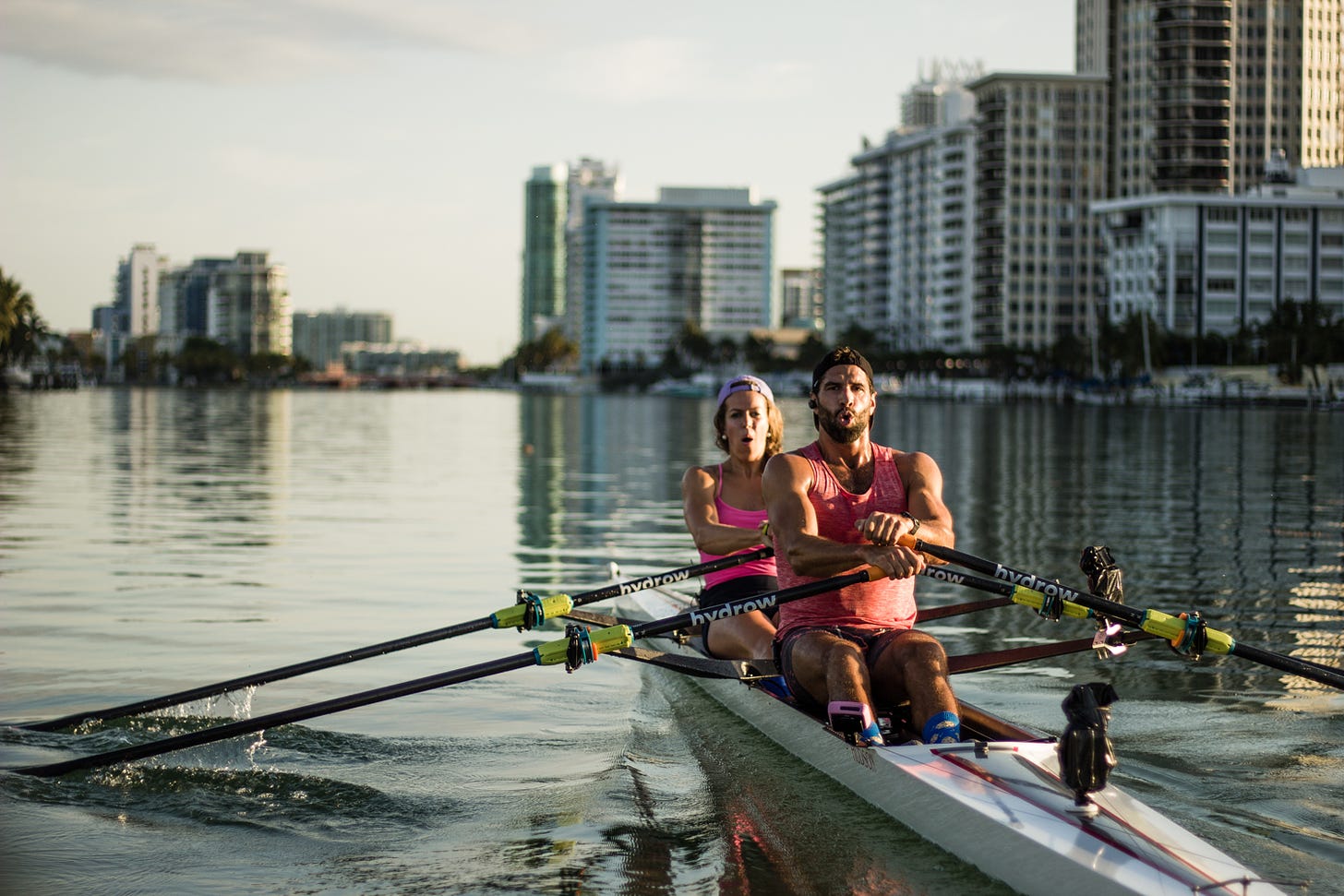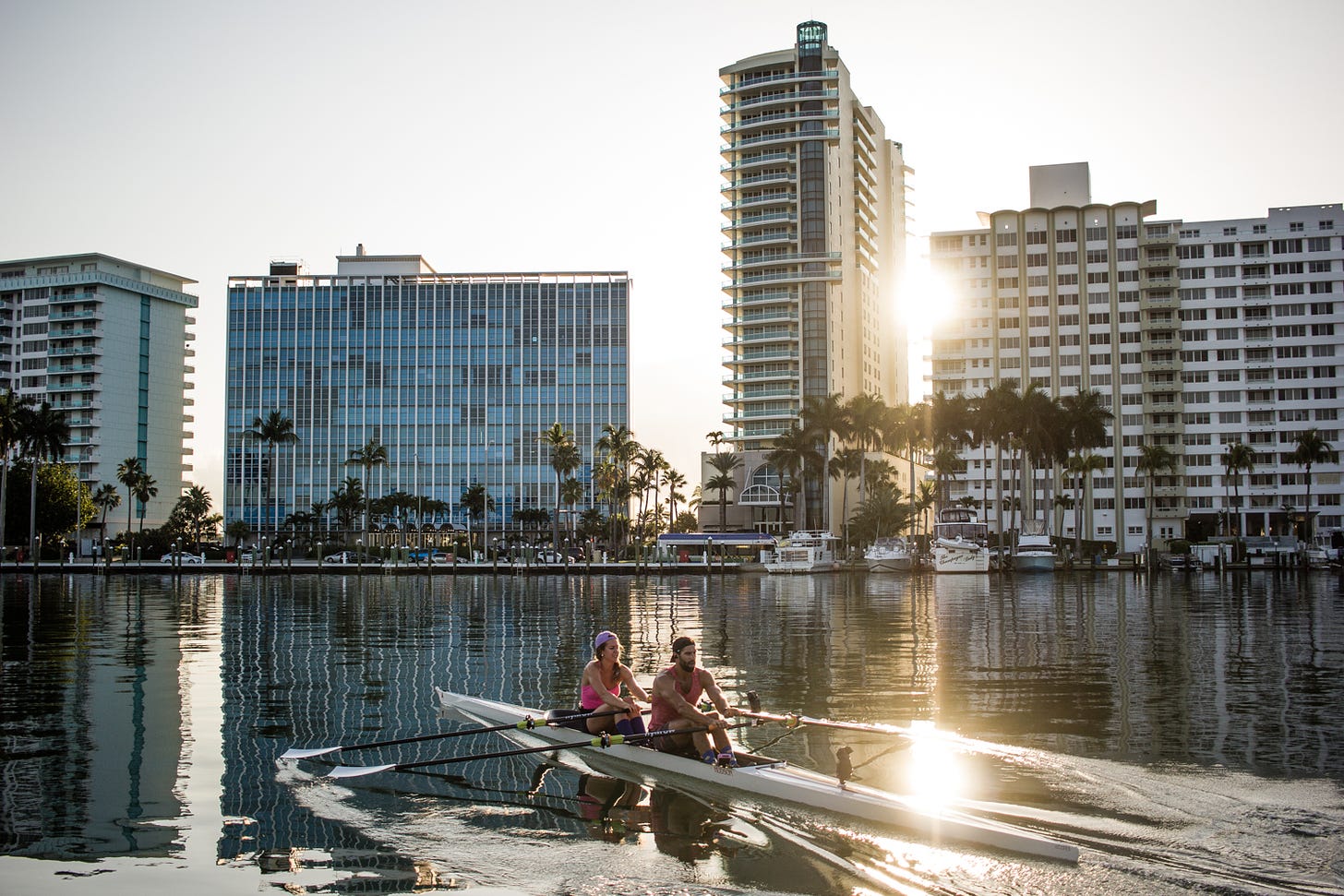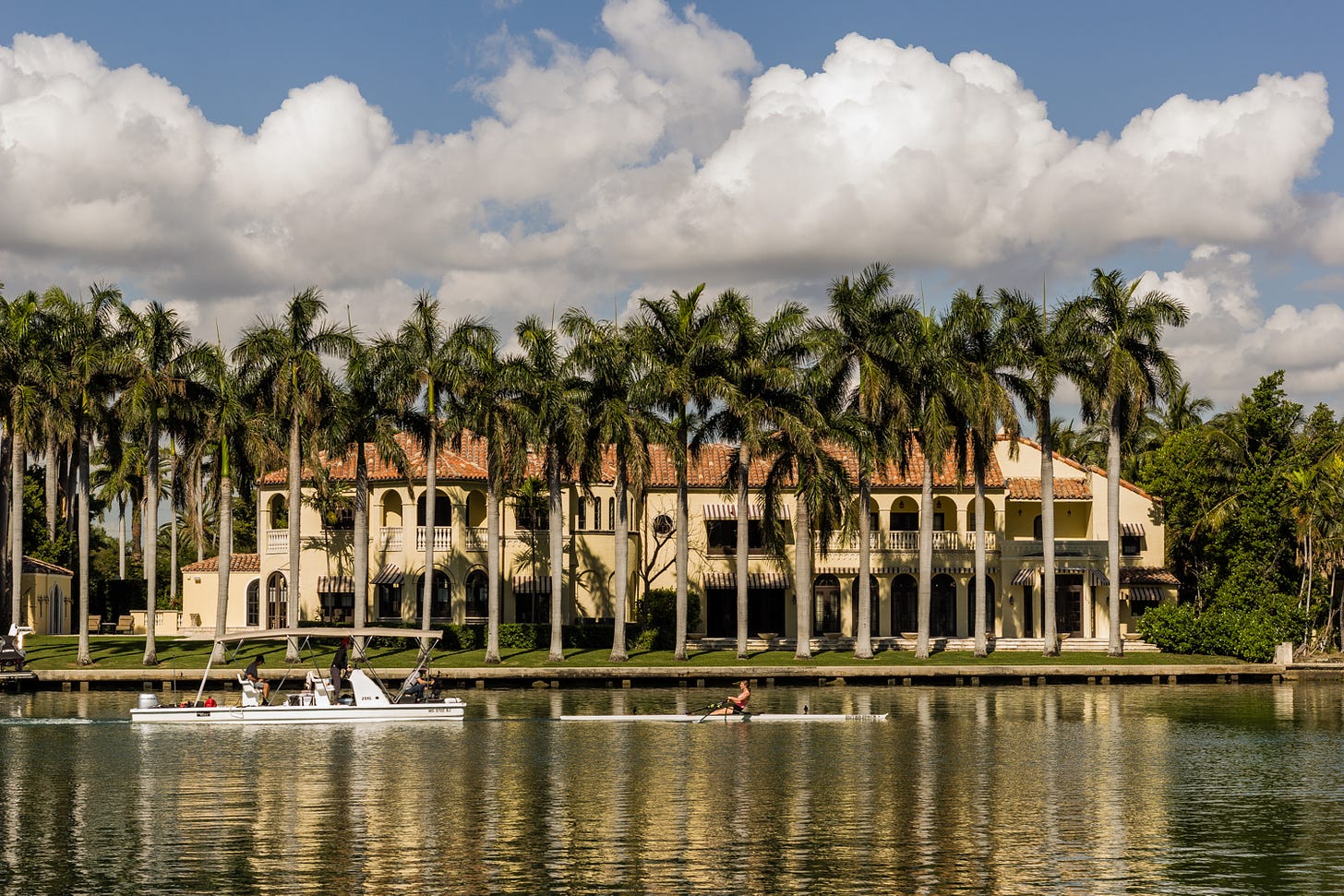Bringing the Real Feel of Rowing to the Masses
CRI Alumni Bruce Smith and Matt Lehrer started Hydrow to bring the authentic appeal (and benefits) of rowing to dry land
Photos by Scott Del Vecchio
“WE DECIDED to do this because we wanted to scale the benefits of rowing,” CEO Bruce Smith, formerly of Community Rowing, Inc. in Boston, says. “We knew that we could continue to build more CRIs, but that would reach thousands, or maybe tens of thousands of people—we wanted to bring rowing to millions of people. So, when Peloton proved the viability of this model, we looked at that and felt we could take a substantial part of the analog experience of being out on the water, and actually recreate that for a huge number of people, which was very attractive to us. It’s very mission-driven from that perspective.”
“I think the thing I would add to that is that the ability to reach people who don’t know that rowing exists—the scale difference is huge, between going to them, and having them come to you,” explains Chief Experience Officer—also formerly of CRI—Matt Lehrer.
“Bryan—you know that my Midwestern roots run deep. The people I grew up with are never going to hear about rowing [with the old model], because there’s never going to be a way to put a rowing club near them. That problem will never be solved—rowing is a microscope speck inside of a dust molecule, in terms of the number of people involved in rowing in the United States. So, that ability to go to them, and share all the wonderful things we know, that we’ve had the privilege of experiencing—that’s a really different model from saying ‘come to us at a certain time or place.’”
While this strategy and approach is one that I’ve seen before in my own experience, working with Josh Crosby at Indo-Row (a program he built and sold to Equinox), this is a revolutionary approach in terms of the overall experience of the machine. While Josh did an excellent job of building a simple, rowing-style ‘culture’ into his programmatic classes (teamwork, timing, celebrating the success of the group), what Hydrow is able to do is virtually transport the user onto the water, in a realistic and engaging way.
That is key if they want to get the kind of large-scale fitness market penetration they’re looking for—channel the authentic experience of on-water rowing that .00004% of the US population enjoys, and make it accessible to everyone with room for an erg in their home.
“Going after the people who don’t yet know about rowing is the way we started, but we don’t want to do that without bringing to the forefront all the aspects of the sport that rowers know are really life changing—teamwork, accountability, and dedication,” Lehrer says. “So I think that’s where some of the challenges are—building something that is authentic to rowing and not made-up, but also doing that in a way that hasn’t been done before in terms of media.”
He continues: “That’s why having a giant screen is really important—you want to transport people to the river. That’s why it’s important to have an understanding that the people doing the workout at the same time as you are your teammates, not your competitors—they’re your teammates because they help to push you to be your best self. Rowers know that because you’re in the same boat, following a rhythm. And the biggest thing is the actual rhythm—rowers have this unconscious experience, where they’re not making decisions, and instead are just taking what’s in front of them and falling in line. It really makes your brain go to a state that is not accessible for the general population, but it’s a feeling that all rowers know.
“Most people are jumping from one thing to the next, ping-ponging around. Rowers have this state of flow because they just fall into a rhythm. Rowing provides that in a way that most people don’t experience.”
Thinking about market penetration, it’s impossible not to think of an old Mike Teti story about someone who was supposed to be training while traveling. I can’t tell it as well as Teti, but to the best of my memory it goes something like this:
A guy training for the national team is away from the training center for a while, and when he returns, he sheepishly informs Teti that he was unable to complete all the assigned workouts on the erg, because he didn’t have access to one. Teti thinks that’s odd, since he had recently traveled cross country and encountered them in random Holiday Inn locations in the Midwest. So, intrigued, Teti asks, “well, where were you?”
The rower responds, “Boston.”
All that is an elaborate way of saying that Concept2 has actually done a remarkable job getting market penetration in the fitness community already—seemingly every gym in America has one of their machines. But all too often, it’s either sitting, neglected in a corner, or being used (dare I say ‘abused’) by someone with no idea what s/he is doing. So, how can Hydrow square that circle?
“To us it’s about creating connection and community, and part of that is accountability,” Smith explains. “That is, other people knowing that you exist, being in a boat, etc.
“It’s also about telling stories. Rowing has this deeply engrained culture, just from the past 50 or 60 years—it didn’t start this way, people used to tell stories about rowers all the time a century ago—where Harry Parker and this idea of not talking about it has kind of dominated. This idea of where you don’t talk about it, and if you do you’re probably bragging or not trustworthy, has just led to a whole bunch of rowers not telling their stories very well.
“As a sport, we’re not inherently more boring than golf. Golf takes four hours, and it’s a person hitting a tiny ball across a lawn. When you look at the substance of our sport, it’s not inherently bad. It’s that we’ve become bad at storytelling. We want to create that connection between our athletes and the people at home. The analogy that we always use is that the person at home is our Batman, and the athlete is Robin—the real hero of this is the person at home, the community at home working out with us, and we are all Robins, helping them to accomplish this mission of feeling better, getting fit, and feeling connected to other people.”
Having tested the machine (if only for a few minutes here in San Francisco), it feels similar to the Concept2 in terms of the smooth drive and acceleration through the stroke, though it’s a belt drive versus a chain (a decision to limit noise). So, as a rower, it’s a familiar experience/feel, with the addition of the large touch screen. But what about for newbies?
“For people who have never rowed before, we think we have a really good solution because that screen is revolutionary,” says Smith. “You used to be just on your own. Now, you’re being guided very specifically by people who have done tens of thousands of hours in the sport.
“Every single workout includes some learning [about rowing technique].”
Lehrer adds, “I think it’s hard to appreciate how different it is when you have to tell someone with your words—it can be very difficult to communicate the rowing stroke. If you say (and we’ve tested this in a bunch of different places) watch this person and do what they’re doing, and nothing else, people typically start rowing with ok technique in less than a minute. It’s not amazing—they don’t learn to row in one minute—but you eliminate so many complications when you just say follow that person because humans are evolved to move with other humans…I didn’t believe it until I saw people do it. I had to watch it happen to prove it to myself.”
According to Smith, this basically sums up the experience of the first would-be investor in Hydrow—that is, he had never rowed before, but after being set up with a screen and a machine, he sat down and got started, and immediately understood the appeal. “He was like, oh, I get it. I’d like to invest in the company,” Smith says.
One of the central components of the Hydrow approach is what they call LOR, or ‘Live Outdoor Reality,’ which is meant to give that authentic feeling of experiencing the world from the water. “Most rowers take it for granted, but it’s unbelievably special to see the world from that perspective, and it’s just crazy beautiful,” says Smith. “The colors, the light—it’s truly unique and special.”
That also means it’s difficult to capture, and it’s clear that Hydrow feels it’s important to distance themselves from the competition in this regard.
“We’re not just putting GoPros on boats. We’ve hired a really, really talented team…I think it’s substantially different from a lot of the content that gets generated around workouts. People think that working out is just a mechanical thing…it takes a lot more to recreate the experience of being out on the water,” Smith explains.
“We believe really strongly that we want to draw you into the experience of your workout, and have you be present in the moment that you’re doing it,” outlines Lehrer. “The reason there are TVs in gyms, and people want to watch movies while doing steady-state ergs, is that they’re trying to transport themselves away from the experience of working out and using their bodies. For us, it’s a re-orientation of that mindset—we think that you’re doing something wonderful, and we want to help you experience that fully, as opposed to trying to distract you from something that inherently isn’t great, and this makes it slightly less bad. That’s the opposite of our perspective.
“Think about it—when you’re rowing on the water, you’re never saying to yourself, ‘I really wish I were watching a movie right now.’”
Hydrow aren’t the only ones trying to get bigger screens onto rowing machines. Recently, NordicTrack released a new machine that looks similar, and also has pre-recorded training videos. But evidently that’s where the similarities end.
“Anytime someone else joins this field, we’re delighted, because we believe that nobody should ever buy another treadmill, once they understand the benefits of rowing,” Smith says. “They’ve built a machine that is really similar to a Concept2, and they have filmed 100 workouts that are static and available…they’re machine is substantially different from ours in that it relies on wind resistance.”
In addition to the videos being pre-fab versus live (Smith: “We’re filming three episodes a day, so there’s always new stuff—it’s not just new stuff but the story develops as you go…”), Smith touches on another interesting item here—apparently, the belt drive system of the Hydrow rower is actually controlled electronically, so the resistance is managed by software, giving it virtually endless potential for variation.
That, in addition to the emphasis on new content, is where Lehrer and Smith really see a separation from the field. While the majority of the episodes are in Miami Beach and Boston at time of writing, the ‘travel’ component of the platform is slated to expand in the near future—all part of bringing the authentic rowing experience to the athlete at home, as well as leveraging the international nature of the sport.
“We’re going to be rolling out a bunch of super nifty locations—that’s one of the characteristics of the rowing community, part of the things we can do to delight and engage our community are key elements for us.” //RR
You can learn more about Hydrow via their official website. Thanks to Matt Lehrer and Bruce Smith for taking the time, and to Scott Del Vecchio for contributing the images! Follow Scott on Instagram.
Stay in touch:
Facebook | Instagram | Twitter | LinkedIn
-RR
—30—









